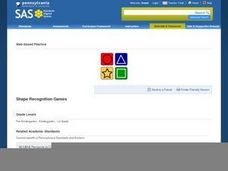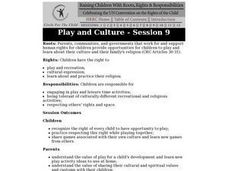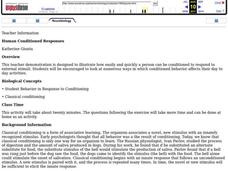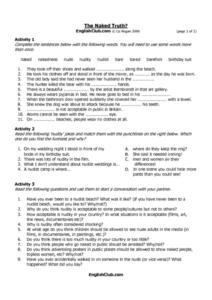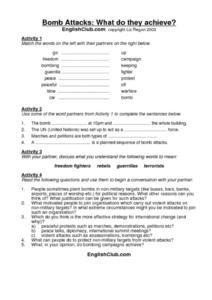Curated OER
Number Recognition Games
Students explore number sense by participating in a math recognition activity. In this number identification lesson, students practice pronouncing names of numbers and matching the number with an amount of objects. Students practice...
Curated OER
Shape Recognition Games
Students explore shapes. In this math activity, students identify basic geometric shapes. Students complete activities in which they identify shapes, symbols and letters. Students draw geometric shapes.
Curated OER
Earthquake!
Learners gain an understanding of earthquakes. They examine vocabulary associated with earthquakes, how earthquakes happen, and preventive measures taken to diminish damage or harm in the event that an earthquake should happen.
Curated OER
Short 'e'
First graders recognize the short vowel e in written and spoken language. Through matching activities, they discriminate the short vowel /e/ from other phonemes. Students associate the phoneme with its letter representation and identify...
Curated OER
Childhood
In this writing worksheet, pairs of students examine, discuss and complete a variety of activities associated with all the aspects of childhood. The activities are thought-provoking. Students must read a selection on a website embedded...
Alabama Learning Exchange
The Four Seasons
Students who are special needs and early elementary students study facts about the four seasons. They listen to read aloud books about each season before completing associated graphic organizers. They illustrate pocket books to hold all...
Curated OER
Lesson One: Characterizing Philanthropic People
Familiarize your class with philanthropy and involve individuals in philanthropic activities. First, determine the traits of philanthropic people. Class members attach sticky notes with character traits written on them to each side of at...
Curated OER
Language Arts:Similes That Make Us Smile
Students identify similes and create their own self descriptions using them as examples. After identifying characteristics associated with pictures of the sun, fish, and other items, they discover how those traits can be used as...
Curated OER
Computer Security Day
In this computer security day worksheet, students match phrases, fill in the blanks, choose the correct words, unscramble words and sentences, write discussion questions and conduct a survey.
Curated OER
Introduction to Polynomials
Students analyze the graphs of polynomial functions, examine vocabulary associated with polynomials, and determine the maximum number of real roots possible for a polynomial
Curated OER
Play and Culture
Pupils discuss with their parents the rights of every child to have the opportunity to play. They share games associated with their own culture and learn new games from others. They examine how the value of play for a child's...
Curated OER
The Anasazi
Sixth graders investigate and determine the origins of the ancient Anasazi who inhabited present-day Utah and the Four-Corners-Region, after receiving direct instruction and carrying out activities in cooperative group settings. They...
Curated OER
Is Halloween Harmful?
In this is Halloween instructional activity, students, with a partner, examine, research, discuss and complete a variety of activities associated with Halloween.
Curated OER
Recognize Triangles
In this shapes worksheet, students are asked to "colour" all of the triangles they find on the page. There are 10 shapes on the page and 4 are triangles. The second page contains suggestions for teachers on activities with 2-D shapes.
Curated OER
Human Conditioned Responses
High schoolers listen as the teacher demonstrate how easily and quickly a person can be conditioned to respond to external stimuli. Students are encouraged to look at numerous ways in which conditioned behavior affects their day to day...
Curated OER
Worms And More
Students complete five center activities that in order to determine the attributes of length and area. They study the vocabulary associated with measurement of length and area. They use blocks, play dough, wrapping paper, and footprints...
Curated OER
Gulping Guppies
Students recognize the phoneme /g/. Through listening and matching activities, students discriminate the phoneme /g/ from other letters and phonemes. They associate the phoneme /g/ with its letter representation and identify the phoneme...
Curated OER
Listening to Letter Sounds
Pupils review the sounds and letters that coorespond to them. Using a voice recorder, they say the sounds and letters being taught at that given time. They use the recorded messages to complete an activity using the letters and sounds.
Curated OER
Business Cycles in the Four-Corners
Learners are introduced to new vocabulary associated with business cycles. In groups, they read excerpts from their textbook about the causes and effects of business cycles. To end the instructional activity, they identify the...
Curated OER
Smile Smarts Oral Health Curriculum
Students are given information on good oral health and tooth protection that is appropriate to their age and lifestyle. They discuss how adult permanent teeth are meant to last the rest of their life. Students are given a copy of "Teeth...
Curated OER
The Naked Truth?
In this the naked truth worksheet, students, with a partner, complete eleven sentences with words from a word band associated with being naked, match up four nudity jokes with their appropriate punchlines and have a conversation over...
Curated OER
Bomb Attacks: What Do They Achieve?
In this bomb attacks and what do they achieve instructional activity, students, with a partner, examine, analyze, discuss and complete a variety of activities associated with bombs and the effects of them worldwide.
Curated OER
Color
In this color worksheet, students, with a partner, explore and discuss a variety of activities associated with a large variety of colors, and how colors are significant to various countries. An interesting writing assignment is at the...
Curated OER
Exercise in Perspective
In this exercise in perspectives, students are required to analyze a topic by completing six different activities. Students can work in groups, pairs or independently to complete the activity.



